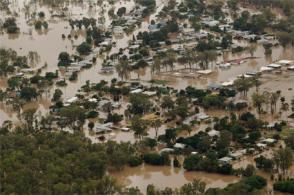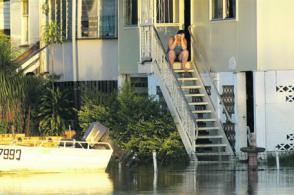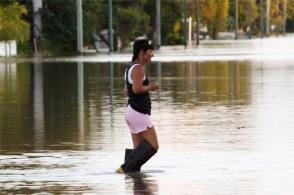
In the growing crisis military aircraft were rushing to get supplies to residents, to whom there is now only one land access route left.
Police were desperately urging people to stay out of the snake-infested waters, that have so far claimed the lives of three people.
More than 500 homes in the city have been evacuated but some residents are refusing to leave, Australian broadcaster ABC reported.
In other areas of Queensland, residents were beginning the recovery process, while others prepared for fresh floods.
The major highway through the city looks more like a major river. Were it not for the tops of road signs poking out it would be unrecognisable as one of Australia's main arterial routes.
In its lower-lying suburbs, 150 houses were already under water, and more than 400 people had fled their homes. A coast city at the mouth of the swollen Fitzroy River, this should be the last stop before the surging floodwaters reach the ocean, but it's thought Rockhampton could be under water for the next 10 days.

Last night Australian Prime Minister Julia Gillard described the situation as "a major natural disaster" and said recovery would take "a significant amount of time".
The US was the latest nation to offer its assistance in the recovery of Queensland.
US Secretary of State Hillary Clinton said: "Australia is an important partner and close friend of the United States and we stand ready to provide assistance."
More than 20 towns across a huge swathe of Queensland have been cut off or flooded, and more than 200,000 people affected.
In the town of Emerald, locals have begun sifting through their flood-damaged belongings, as flood waters recede from the Nogoa River, which flooded more than 1,000 houses.
The flood crisis has also had a huge impact on the region's coal industry.
Premier Anna Bligh said 75pc of operations had been halted at the state's coalfields, which supply just under half of the world's coking coal needed in steel manufacturing.
Rockhampton is at the centre of the state's flood emergency, with its 75,000 residents bracing for the Fitzroy River to peak at about 9.4m (31ft).
Mayor Brad Carter told the BBC that levels were currently about 9.2m, and warned that the floods may not recede for weeks.
A major highway north of the city is still open but officials say it could be impassable within hours.
With Rockhampton's airport closed, supplies are being delivered to the city by military helicopters and barges.
With the flood peak still several hours away and many residents refusing to leave, emergency services are preparing to rescue those in trouble.
Impassable
Emergency teams have set up a "tactical medical centre" with dozens of tents at the small airport in the coal port of Gladstone, about 100km south of Rockhampton.
Jason Foss owns a small business in Rockhampton. He told the BBC: "It is a nightmare. Daily life has become incredibly complicated. Many roads remain impassable. The authorities have warned residents to be wary of snakes and crocodiles.
"Our business has suffered the brunt. I've just started clearing out the flood damage. Ripping out all the carpets, throwing out ruined desks and binning water-logged computers. The emotional cost is staggering."

The cost of thermal coal, used to generate electricity, rose $5 to $131 (€3.76-€98.52) a tonne yesterday. The price has risen by 35pc since October because of strong demand and supply problems in several countries.
The price of coking coal, used to make steel, has increased by about 10pc to $253 (€190) a tonne over the past week, largely as a result of the flooding in Queensland. Analysts said that the price was likely to rise to $300 or even $350 (€225-€263) a tonne as the full impact of shortages was felt.
Shipping brokers estimated that about 40pc of the global seaborne coal market had been shut down by the floods.



Reader Comments
to our Newsletter